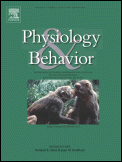Physiology & Behavior: Difference between revisions
Content deleted Content added
removed Category:Behavioral neuroscience; added Category:International Behavioral Neuroscience Society academic journals using HotCat Tag: Reverted |
Randykitty (talk | contribs) |
||
| Line 31: | Line 31: | ||
{{DEFAULTSORT:Physiology and Behavior}} |
{{DEFAULTSORT:Physiology and Behavior}} |
||
[[Category: |
[[Category:Behavioral neuroscience]] |
||
[[Category:Neuroscience journals]] |
[[Category:Neuroscience journals]] |
||
[[Category:Physiology journals]] |
[[Category:Physiology journals]] |
||
Revision as of 07:51, 3 September 2022
 | |
| Discipline | Behavioral neuroscience, physiology |
|---|---|
| Language | English |
| Edited by | Thomas Lutz |
| Publication details | |
| History | 1966-present |
| Publisher | |
| Frequency | 15/year |
| 3.244 (2020) | |
| Standard abbreviations | |
| ISO 4 | Physiol. Behav. |
| Indexing | |
| CODEN | PHBHA4 |
| ISSN | 0031-9384 (print) 1873-507X (web) |
| LCCN | 66009937 |
| OCLC no. | 643803838 |
| Links | |
Physiology & Behavior is a peer-reviewed scientific journal published by Elsevier. It covers the fields of behavioral neuroendocrinology, psychoneuroimmunology, learning and memory, ingestion, social behavior, and studies related to the mechanisms of psychopathology. It was established in 1966 with Matthew J. Wayner as its founding editor-in-chief. The current editor-in-chief is Thomas Lutz (University of Zurich).
Abstracting and indexing
The journal is abstracted and indexed in BIOSIS, Chemical Abstracts, Current Contents/Life Sciences, MEDLINE, PsycINFO, Science Citation Index, Scopus, and PubMed.[1] According to the Journal Citation Reports, the journal has a 2020 impact factor of 3.244.[2]
References
- ^ "Physiology and Behavior - Indexing Information". Retrieved 2009-05-10.
- ^ "Physiology & Behavior". 2020 Journal Citation Reports. Web of Science (Science ed.). Clarivate Analytics. 2021.
External links
